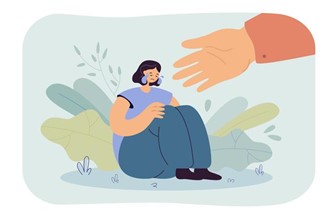Women are victims of different social evils. They are subjected to problems at their homes, at the workplace, in society, etc. One of the significant examples is Domestic Violence. Domestic violence is any form of maltreatment in a domestic setting, such as marriage or cohabitation. Such violence is one of the significant health problems faced by around 2 million women and 8,00,000 men, resulting in physical injury or mental health injury, death, or divorce1

In the present situation where the world is struggling to combat Covid-19, there is a surge in the number of domestic violence cases in India. This has brought out the question of women's safety in her own house into concern. This national lockdown has given a chance for everyone to take a break from their hustle life and settle down at peace and work from home.
But this has also increased the burden of the women in the house. Just like the doctors, the police officers, and the other front-line workers, women in their own households are fighting to serve the family members and to maintain peace at home. But in the past year, between March 23 and April 16, 2020, there are almost 587 Domestic Violence cases registered across the country2.
These are only the cases that are registered; there may be women who are unable to come and talk about the problems faced by them to keep up their family's and partner's reputation. The protection of a woman's dignity is also a big challenge in the current situation.

Being one of the world's oldest judicial systems, the Indian Judiciary is now burdened with several unsettled disputes and cases. Even as fast-track courts are being set up, pending cases continue to rise. In such situations, Alternative Dispute Resolution plays an essential role by its various techniques.
This method resolves the conflict between parties in a peaceful manner and reduces the courts' burden. Alternative Dispute Resolution has its advantages like it is less time consuming; it is free from all the procedures followed in a court; people can freely express themselves without fear of court of law; it preserves the best interests of the parties, and in most of the situations, there are chances of restoring the relationship as the parties discuss their issues together. It is also a cost-effective method.
Marriage is an institution that brings a man and a woman together in a special social and legal relationship to make a home and build a family together. Marriage is a relationship that needs equality and respect individually for both partners. While the courts are busy dealing with the other pending cases, it is a need of the hour to adopt an alternative approach to solve the problems between families.

One of the suitable ways to settling matrimonial disputes is a mediation that comes under Alternative Dispute Resolution. In mediation, the advocates use favorable mechanisms as it safeguards the family relationships, more importantly, the children from having to witness the disputes and provide speedy justice3. One of the modes of alternate dispute resolution is mediation.
A neutral third Party assists the complainant and the other parties related to a dispute to reach an agreement where all of them are satisfied. It is an easy and uncomplicated Party-centered negotiation process where a third Party acts as a mediator to resolve a dispute harmoniously by using the right techniques of proper communication and negotiation. Mediation is entirely controlled by the parties involved in the dispute.
The work of the mediator is to facilitate the parties to settle their dispute. A mediator doesn’t impose his views and does not decide what a fair settlement should be. Mediation gives a sense of confidentiality to the couple, gives them the freedom to express themselves, mutuality, etc. However, mediation can be inappropriate if it is used in cases where there is a clear power imbalance or where is a societal stake in developing law through the adversarial process.

Mediation can work to the disadvantage of women if the authorities are not sensitive to issues that are gender-biased4. Even if a mediator is trying to create a neutral environment, the mediator's own perspectives and biases will show how he or she will perceive the position of the parties related to the case.
Under section 12 of the Protection of Women from Domestic Violence Act, 20055, it is clearly stated that a magistrate must dispose of cases related to this Act within 60 days, although this provision is rarely met. The Arbitration and Conciliation Act, 1996 was the first statute to introduce Mediation. Section 30(1) of the Act encourages the parties involved in a dispute to take up mediation and conciliation as a means of dispute resolution.
But because of the lack of proper enforcement of the provision, the concept of mediation somehow was not known to many people. In 2013, in the case of B. S. Krishnamurthy v B. S. Nagaraj6, the Supreme Court directed the Family Court to settle matrimonial disputes through mediation, especially matters concerning maintenance, child custody, etc.

A woman who faces such atrocities in an intimate partner relationship can be heard through Alternative Dispute Resolution7. Initial report and gathering information- Once a report is filed, the authority must gather information from the woman (the survivor of the Domestic violence) herself to establish her testimony before involving any other individual. The Summons and hearing- Once the authority decides to take up a case, a date will be set for the hearing and summon of the parties involved in the case.
The survivor will be heard first before any other Party without any interruption and will be treated with complete trust and respect by all the members involved in the procedures.
Decision or punishment- The hearing will aim at concluding with mediation, arbitration, or otherwise agreed-upon decision, potentially involving punishment or order for restitution.
Enforcement- Once the decision or the punishment is enforced, the Alternative Dispute Resolution community members would ensure that the terms are followed. The terms are made according to the woman's choices, with the primary goal to prevent any form of further violence.

The setting up of women's courts in India is also one step closer to empowering them. The first Indian Women's Court was opened in West Bengal in 20138. This court was set up to hear all the atrocities faced by a woman and to deliver speedy justice. This court was only to have women staff in it.
"When there are men around, the female victim can't speak up and give details of the atrocity committed against her. They feel shy. In these courts, the victim will get a women-friendly atmosphere," general secretary of All India Legal Aid Forum Joydeep Mukherjee said. Male judges are often not "sensitive towards crimes against women and are biased towards the male gender when hearing a woman's plea," said senior advocate Bharati Mutsuddi9.
The main goal of the women's courts is to avoid matrimonial litigation and to solve problems of the couple, and keep the institution of the family intact. This is achieved through counseling or through mediation between the complainant and the husband or the other relatives. They try to convince the couple to settle their disputes and to accept each other, and give time for the betterment of their relationship, and make changes in their behaviors that have actually created a misunderstanding between them.

Alternative Dispute Resolution, especially mediation, has to be used as the most common solution for any dispute. Awareness for the same has to be spread to common people. For this, it is necessary to identify people or community-based initiatives for taking up the cause of spreading awareness about mediation across the country.
It now seems that we need new ways of looking at conflict resolution and the legal profession and hopes to discover a new way to help bridge bonds between practicing and respecting the law and also to the demands of the Public. Creating awareness in the society of the mediation process and its benefits and developing capacities for the same will help expedite the shift from adversarial litigation to methods of alternate dispute resolution in a big way. This will also help in reducing the backlog of long- pending cases in Indian courts and usher in a new era10.
The promise of justice to the citizens of India that was made under the Indian Constitution is at stake. These constitutional provisions can be fulfilled through the mechanisms of Alternative Dispute Resolution. Alternative Dispute Resolution is a method that is simple, less time-consuming, has fewer technicalities, etc. that promises a solution to ensure justice to the parties involved in a dispute.
Rather than always going before the court, civil disputants should have the option of solving the dispute by an agreement, whether it is directly or a mediator who will help as a third- Party. In certain cases, the choice of Alternative Dispute Resolution must be given in the civil justice system because it is an essential mechanism to provide access to individualized justice for the parties.
Separation is not always a solution for problems that can be solved when communicated among families. Mediation is a help for the same. Alternate Dispute Resolution's motive is to provide social economic justice system to the people and also reduce the burden of the Indian Courts. So it is time to adapt and get used to the services that are provided for the benefit of the community and individuals.
References
1. Roxanne Dryden-Edwards, Domestic Violence, MedicineNet, (March 20, 2021, 11:00 AM),
https://www.medicinenet.com/domestic_violence/article.htm
2. Economic Times,
https://economictimes.indiatimes.com/news/politics-and-nation/india-witnesses-steep-rise-in-crime-against-women-amid-lockdown-587-complaints-received-ncw/articleshow/75201412.cms, (March 20, 2021, 11:30 AM)
3. Anubhav Pandey, All you need to know about Alternative Dispute Resolution (ADR), iPleaders, (May 09, 2017),
https://blog.ipleaders.in/adr-alternative-dispute-resolution
4. Leigh Goodmark, Alternative Dispute Resolution and the Potential for Gender Bias, 39 Judges J. 21 2000, 25,
https://digitalcommons.law.umaryland.edu/cgi/viewcontent.cgi?article=2468&context=fac_pubs
5. Indian Kanoon, (March 20, 2021, 20:30 PM)
https://indiankanoon.org/doc/542601/
6. Indian Kanoon, (March 21, 2021, 10:00 AM)
https://indiankanoon.org/doc/1633972/
7. Brian Heilman, Nastasia Paul-Gera, Tina Musuya, and Sara Siebert, Whose Justice, Whose Alternative? ,
International Center for Research on Women,
https://www.icrw.org/wp-content/uploads/2016/10/ICRW-Mediation-Paper-FINAL.PDF8. First Post, March 21, 2021, 20:00 PM)
https://www.firstpost.com/india/indias-first-court-only-for-women-launched-in-bengal-599369.html
9. Amitabha Bhattasali, India’s First Women’s Court opens in West Bengal, BBC News, (January 24, 2013),
https://www.bbc.com/news/world-asia-india-21175738
10. The impact of Mediation in India, iPleaders, https://blog.ipleaders.in/the-impact-of-mediation-in-india/


